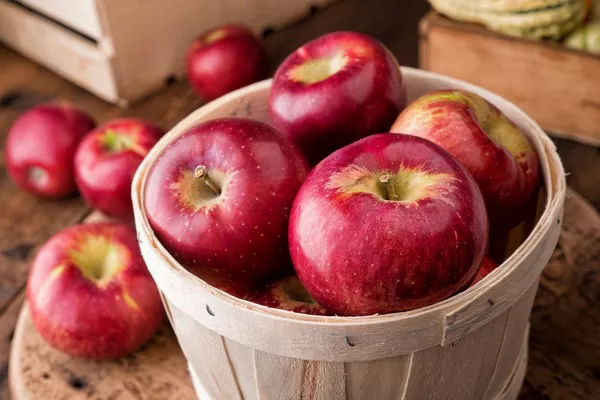Fruits play a central role in the American diet, offering a delicious and nutritious way to satisfy cravings while promoting health and wellness. From the tropical flavors of Hawaii to the orchards of Washington state, the United States boasts a diverse array of fruits enjoyed by people of all ages and backgrounds. In this article, we embark on a culinary journey to explore the 10 most popular fruits in the United States, uncovering the flavors, nutritional benefits, and cultural significance of each beloved fruit.
The 10 Most Popular Fruits in the United States
1. Apples:
As one of the most iconic fruits in American culture, apples hold a special place in the hearts and palates of consumers nationwide. With a crisp texture, sweet-tart flavor, and versatile culinary uses, apples are a staple ingredient in pies, salads, sauces, and snacks. From classic varieties like Granny Smith and Red Delicious to heirloom cultivars such as Honeycrisp and Fuji, apples offer a diverse range of flavors and textures to suit every taste preference.
Nutritional Profile: Apples are rich in dietary fiber, vitamin C, and various antioxidants, which support digestive health, immune function, and cardiovascular health. Additionally, apples contain phytochemicals like quercetin and catechin, which may have anti-inflammatory and anticancer properties.
Cultural Significance: Apples hold cultural significance in American folklore and traditions, symbolizing wisdom, temptation, and the bounty of nature. From the legendary tale of Johnny Appleseed to the annual tradition of apple picking in orchards across the country, apples are woven into the fabric of American heritage and nostalgia.
2. Bananas:
With their creamy texture, tropical aroma, and convenient packaging, bananas rank among the most popular fruits consumed in the United States. Whether enjoyed as a quick snack, blended into smoothies, or sliced atop cereal and yogurt, bananas offer a convenient and nutritious way to satisfy hunger and cravings throughout the day.
Nutritional Profile: Bananas are an excellent source of potassium, vitamin B6, and vitamin C, which support heart health, nerve function, and immune function. Additionally, bananas contain dietary fiber and prebiotics, which promote digestive health and regulate blood sugar levels.
Cultural Significance: Bananas hold cultural significance in American cuisine, particularly in desserts like banana bread, banana pudding, and banana splits. Moreover, bananas feature prominently in popular culture, from the iconic “banana phone” in the animated series “Arrested Development” to the catchy tune of “Yes, We Have No Bananas” in American music history.
3. Oranges:
Renowned for their refreshing flavor, vibrant color, and abundant vitamin C content, oranges are a beloved citrus fruit enjoyed by millions of Americans year-round. Whether juiced for breakfast, segmented in salads, or enjoyed as a healthy snack, oranges offer a burst of sunshine and sweetness to any meal.
Nutritional Profile: Oranges are an excellent source of vitamin C, potassium, and dietary fiber, which support immune function, heart health, and digestive health. Additionally, oranges contain antioxidants like flavonoids and carotenoids, which may help reduce inflammation and lower the risk of chronic diseases.
Cultural Significance: Oranges hold cultural significance in American traditions, particularly during the holiday season, when they are often included in gift baskets and decorative displays. Moreover, oranges feature prominently in American literature and folklore, symbolizing prosperity, vitality, and good fortune.
4. Strawberries:
With their vibrant red hue, juicy texture, and sweet-tart flavor, strawberries rank among the most popular berries consumed in the United States. Whether enjoyed fresh, blended into smoothies, or paired with whipped cream in desserts, strawberries offer a delightful burst of flavor and color to any dish.
Nutritional Profile: Strawberries are rich in vitamin C, manganese, and antioxidants, which support immune function, bone health, and skin health. Additionally, strawberries contain dietary fiber and anthocyanins, which may help reduce the risk of heart disease and improve cognitive function.
Cultural Significance: Strawberries hold cultural significance in American cuisine, particularly in iconic desserts like strawberry shortcake and strawberry jam. Moreover, strawberries are celebrated in festivals and events across the country, such as the annual California Strawberry Festival in Oxnard, California.
5. Grapes:
As one of the oldest cultivated fruits in human history, grapes hold a special place in American agriculture and culinary traditions. Whether enjoyed fresh, dried as raisins, or pressed into wine, grapes offer a diverse array of flavors and culinary uses to satisfy every palate.
Nutritional Profile: Grapes are rich in antioxidants like resveratrol, flavonoids, and polyphenols, which may help reduce inflammation and lower the risk of chronic diseases. Additionally, grapes contain vitamin K, vitamin C, and dietary fiber, which support bone health, immune function, and digestive health.
Cultural Significance: Grapes hold cultural significance in American winemaking traditions, particularly in regions like California, Oregon, and Washington, where vineyards abound. Moreover, grapes are enjoyed in festive occasions like New Year’s Eve, where they are traditionally eaten at midnight to symbolize good luck and prosperity.
6. Blueberries:
With their deep blue hue, sweet flavor, and abundant health benefits, blueberries have gained widespread popularity as a superfood in the United States. Whether enjoyed fresh, frozen, or incorporated into baked goods and breakfast dishes, blueberries offer a delicious and nutritious way to boost antioxidant intake and support overall well-being.
Nutritional Profile: Blueberries are packed with antioxidants like anthocyanins, flavonoids, and phenolic acids, which help reduce oxidative stress and inflammation in the body. Additionally, blueberries are rich in vitamin C, manganese, and dietary fiber, which support immune function, bone health, and digestive health.
Cultural Significance: Blueberries hold cultural significance in American cuisine, particularly in regional specialties like blueberry pie, blueberry pancakes, and blueberry muffins. Moreover, blueberries are celebrated in festivals and events across the country, such as the annual National Blueberry Festival in South Haven, Michigan.
7. Watermelons:
With their juicy flesh, sweet flavor, and refreshing taste, watermelons are a quintessential summer fruit enjoyed by Americans of all ages. Whether sliced at picnics, blended into cocktails, or served in fruit salads, watermelons offer a hydrating and delicious way to beat the summer heat.
Nutritional Profile: Watermelons are rich in water content, making them an excellent hydrating fruit during hot weather. Additionally, watermelons contain vitamins A and C, potassium, and antioxidants like lycopene, which support eye health, immune function, and cardiovascular health.
Cultural Significance: Watermelons hold cultural significance in American culinary traditions, particularly in Southern cuisine, where they are enjoyed in dishes like watermelon salad, watermelon gazpacho, and watermelon sorbet. Moreover, watermelons are featured in festivals and events across the country, such as the annual Watermelon Thump in Luling, Texas.
8. Pineapples:
With their tropical flavor, golden hue, and distinctive appearance, pineapples are a popular fruit enjoyed by Americans as a symbol of hospitality and warmth. Whether sliced for snacking, grilled for desserts, or blended into smoothies, pineapples offer a delicious and versatile way to add a taste of the tropics to any dish.
Nutritional Profile: Pineapples are rich in vitamin C, manganese, and bromelain, a group of enzymes with anti-inflammatory and digestive benefits. Additionally, pineapples contain antioxidants like vitamin A and beta-carotene, which support immune function and eye health.
Cultural Significance: Pineapples hold cultural significance in American hospitality traditions, particularly in the South, where they are often displayed as a welcoming symbol in homes and businesses. Moreover, pineapples are featured in festive occasions like Hawaiian-themed parties and luau celebrations.
9. Avocados:
As a nutrient-dense fruit rich in healthy fats, vitamins, and minerals, avocados have surged in popularity among health-conscious consumers in the United States. Whether mashed into guacamole, sliced on toast, or blended into smoothies, avocados offer a creamy texture and mild flavor that complements a wide range of dishes.
Nutritional Profile: Avocados are rich in monounsaturated fats, which promote heart health and satiety, as well as vitamins K, C, and E, which support bone health, immune function, and skin health. Additionally, avocados contain potassium, dietary fiber, and antioxidants like lutein and zeaxanthin, which help reduce the risk of chronic diseases.
Cultural Significance: Avocados hold cultural significance in American cuisine, particularly in Mexican-inspired dishes like tacos, burritos, and salads. Moreover, avocados are celebrated in events like the annual California Avocado Festival in Carpinteria, California, where they are showcased in various culinary creations.
10. Peaches:
With their soft texture, sweet flavor, and fragrant aroma, peaches are a beloved stone fruit enjoyed by Americans during the summer months. Whether eaten fresh, grilled for desserts, or preserved in jams and pies, peaches offer a taste of summer sunshine and nostalgia in every bite.
Nutritional Profile: Peaches are rich in vitamins A and C, which support immune function, skin health, and vision, as well as dietary fiber, which promotes digestive health and satiety. Additionally, peaches contain antioxidants like flavonoids and phenolic acids, which help reduce inflammation and protect against chronic diseases.
Cultural Significance: Peaches hold cultural significance in American culinary traditions, particularly in Southern cuisine, where they are featured in iconic dishes like peach cobbler, peach pie, and peach preserves. Moreover, peaches are celebrated in festivals and events across the country, such as the annual Georgia Peach Festival in Fort Valley, Georgia.
Conclusion:
From the orchards of Washington state to the citrus groves of Florida, the United States is home to a rich tapestry of fruits that reflect the nation’s diverse landscapes, cultures, and culinary traditions. Whether enjoyed fresh, cooked, or blended into smoothies, these 10 most popular fruits enrich our lives with their vibrant flavors, nutritional benefits, and cultural significance. As we celebrate the bounty of nature’s harvest, let us savor the sweetness and abundance of America’s favorite fruits, cultivating a deeper appreciation for the natural world and the nourishment it provides for body, mind, and soul.
You Might Be Interested In:



























